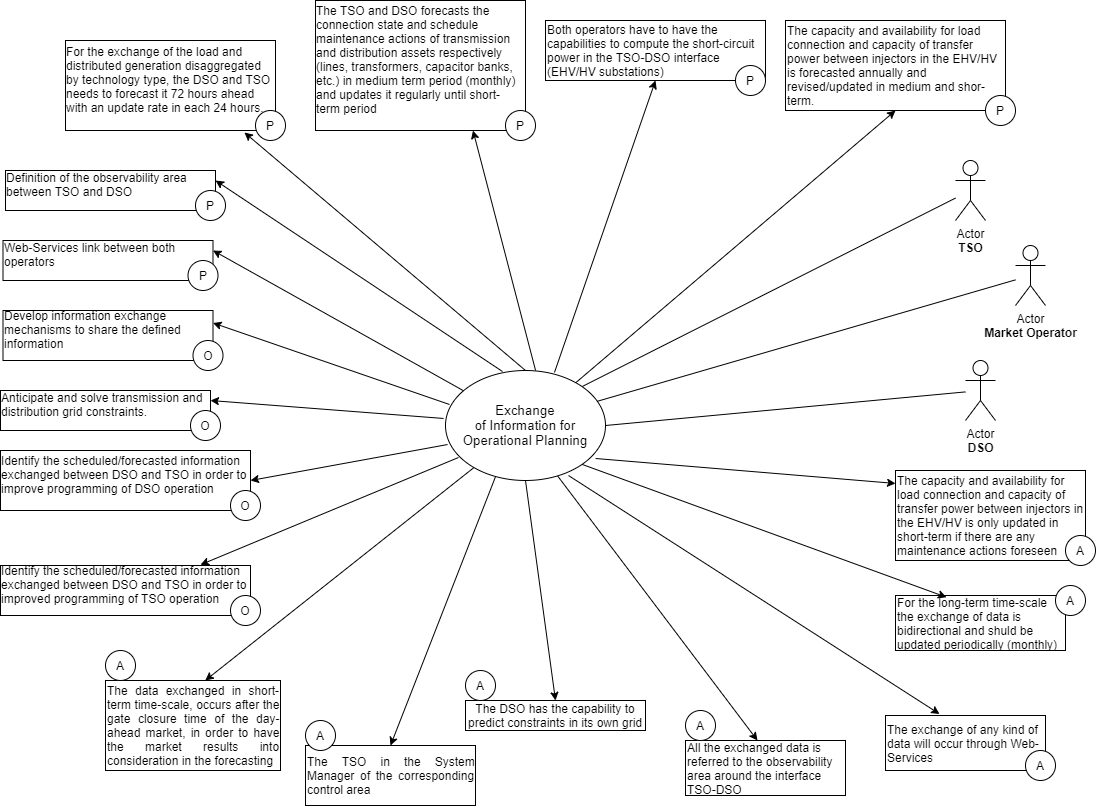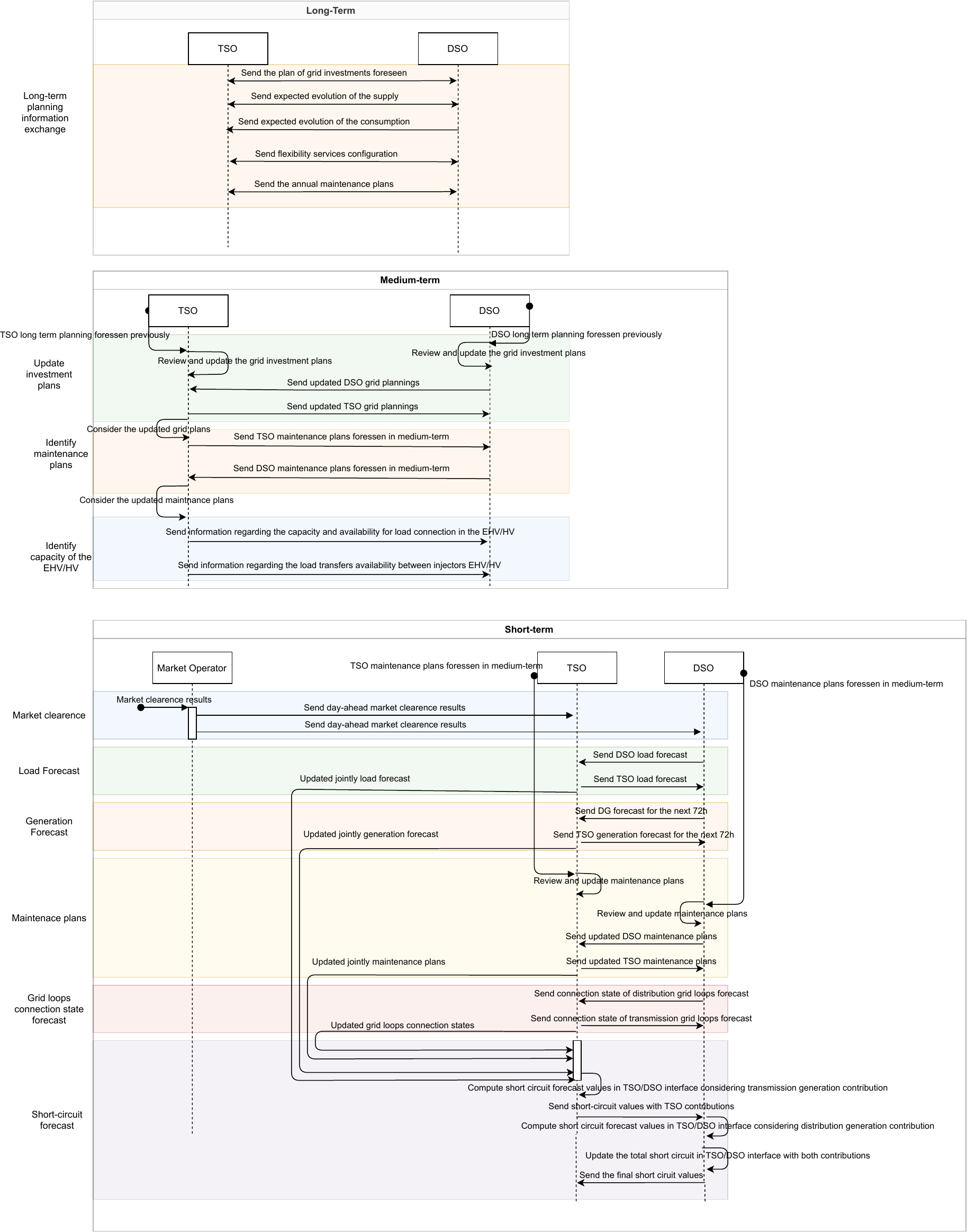WECL-PT-03
1. Description of the Use Case
1.1. Name of the Use Case
| ID | Area /Domain(s)/Zone(s) | Name of the Use Case |
|---|---|---|
| 1 | None, | WECL-PT-03 |
1.2. Version Management
| Version No. | Date | Name of author(s) | Changes | Approval status |
|---|---|---|---|---|
| None | 2021-07-05T00:00:00 | E-REDES | ||
| NESTER | ||||
| REN | ||||
| INESC TEC, | None | None |
1.3. Scope and Objectives of Use Case
| Scope | This BUC is focused on defining and describing the TSO and DSO information exchange, aiming to improve and facilitate long-term to short-term operational planning for both networks. |
| Objective(s) | 1-Identify the scheduled/forecasted information exchanged between DSO and TSO in order to improve programming of DSO operation. |
2-Identify the scheduled/forecasted information exchanged between DSO and TSO in order to improve programming of TSO operation.
3-Anticipate and solve distribution grid constraints.
4-Anticipate and solve transmission grid constraints.
5-Develop information exchange mechanisms to share the identified information. | | Related business case(s) | This BUC 3 defines some information exchanges with the objective of enhance operational planning activities of the TSO and DSO, namely in what concerns to the use of flexibility for the Congestion Management (described in WECL-PT-01 and WECL-PT-02). |
1.4. Narrative of Use Case
Short description
This BUC focus on the enhancement of information exchange that enables better operational planning for DSOs and TSOs.
Complete description
The increase in generation from renewable resources, with its uncertainty, and the increase in the use of electricity (due to EVs for example) means that system operators have to improve their strategies for managing the grid more efficiently in order to avoid unnecessary investments. In this BUC, our strategy is to optimize coordination between DSO and TSO by identifying and sharing the information that enables better operational planning for their networks.
This Business Case is related to BUC-1 and BUC-2, since some of the information covered in this use case can be used in both.
This UC explores and intends to define the information exchange principles between TSO and DSO in order to improve the operation of both networks, in multiple domains and timeframes.
For the long term, will be defined the information that needs to be exchanged bidirectionally regarding the expected evolution of the transmission and distribution grids and their associated supply, consumption, production and flexibility services configuration.
Concerning the medium term, the effort will be focused on the definition of the information regarding the capacity and availability for load connection in the EHV/HV substation, as well as the information regarding the load transfers availability between EHV/HV interconnecting points, providing a better management of the distribution network loops by the DSO. This allows, in case of emergency, the possibility of the DSO to manage the transfer of load between networks.
For the efficient use of the flexibility services and enhancement of the operational planning, the increase of the information exchanged on short-term is key. Once well-defined the observability area of both operators around the TSO-DSO border, the focus will be in the definition of information to exchange about:
-Short-circuit power at the TSO-DSO border;
-Scheduled maintenance actions in the observability area
-Aggregated consumption and production forecast by technology (solar, wind, hydro, etc)
The short-circuit power at the HV bay in the physical border of the TSO-DSO interface (EHV/HV substations) is important to keep tracking due to the increase of the DER that actively contribute to the increase of the short-circuit levels. The short-circuit levels should be tracked in order to ensure that they are kept bellow the rated short circuit current of the circuit breakers in the interface TSO/DSO. This information should be computed and exchanged after the gate-closure time of the day-ahead market in order to use the market results to robustly forecast the short-circuit levels at nodal level in the observability area.
Due to the impact that distribution network loops, close to the TSO-DSO interface, can have in the transmission power flows, the share of the information about the scheduled maintenance plans becomes crucial for the TSO operational planning. On the other side, to the DSO, the TSO can share information about the connectivity status and maintenance plans of the transmission lines between EHV/HV substation with some impact in the distribution grids power flows near the border.
For an efficient and secure operation of the power system, it is fundamental to include an accurate forecast of the load and generation into the TSO operational planning framework. Having in mind that the DSO has their own forecasting methods for the DERs generation and load connected to the distribution networks. Both forecasts can be aggregated by technology and per grid node of the observability area. This information, when shared with the TSO, can have great potential to enhance the TSO operational planning activities
The final goal of this use case is to set a greater cooperation in information exchanges between TSO-DSO within a common observability area for operational planning purposes and identify future flexibility needs in the transmission and distribution networks.
1.5. Key Performance Indicatiors (KPI)
| ID | Name | Description | Reference to mentioned use case objectives |
|---|
1.6. Use case conditions
| Assumptions |
|---|
| WECL-PT-03 |
| Prerequisites |
|---|
| WECL-PT-03 |
1.7. Further information to the use case for classification/mapping
| Relation to other use cases |
|---|
| Level of depth |
| Prioritisation |
| High level of priority |
| Generic, regional or national relation |
| Generic |
| Nature of the use cases |
| Business Use Case |
| Further keywords for classification |
| TSO-DSO coordination, data exchange, operational planning, observability area |
1.8. General remarks
| General remarks |
|---|
2. Diagrams of Use Case


3. Technical Details
3.1. Actors
| Actor Name | Actor Type | Actor Description | Further information specific to this Use Case |
|---|---|---|---|
| DSO | Role | According to the EDSO, the DSOs are “the operating managers (and sometimes owners) of energy distribution networks, operating at low, medium and, in some member states, high voltage levels (LV, MV)”. | |
| TSO | Role | According to the European Commission, the TSO is “an organisation committed to transporting energy in the form of natural gas or electrical power on a national or regional level, using fixed infrastructure”. The certification procedure for TSOs is listed in Article 10 of the 2009 Electricity and Gas Directives. | |
| Market Operator | Role | According to Article 2(7) of the Regulation (EU) 2019/943 of the European Parliament and of the Council of 5 June 2019 on the internal market for electricity (recast), market operator designates “an entity that provides a service whereby the offers to sell electricity are matched with bids to buy electricity”. |
3.2. References
| No. | References Type | Reference | Status | Impact on Use Case | Organistaor / Organisation | Link |
|---|
4. Step by Step Analysis of Use Case
4.1. Overview of Scenarios
| No. | Scenario Name | Scenario Description | Primary Actor | Triggering Event | Pre-Condition | Post-Condition |
|---|---|---|---|---|---|---|
| 1 | Long-term information exchange | Describes the information exchange for operational planning in long-term time frame | Long-term information exchange | |||
| 2 | Medium-term information exchange | Describes the information exchange for operational planning in medium-term time frame | Medium-term information exchange | |||
| 3 | Short-term information exchange | Describes the information exchange for operational planning in short-term time frame | Short-term information exchange |
Notes
4.2. Steps – Scenarios
| Scenario Name: |
|---|
| Long-term information exchange |
| Step No. | Event. | Name of Process/ Activity | Description of Process/ Activity. | Service | Information Producer (Actor) | Information Receiver (Actor) | Information Exchanged | Requirements, R-ID |
|---|
| Scenario Name: |
|---|
| Medium-term information exchange |
| Step No. | Event. | Name of Process/ Activity | Description of Process/ Activity. | Service | Information Producer (Actor) | Information Receiver (Actor) | Information Exchanged | Requirements, R-ID |
|---|
| Scenario Name: |
|---|
| Short-term information exchange |
| Step No. | Event. | Name of Process/ Activity | Description of Process/ Activity. | Service | Information Producer (Actor) | Information Receiver (Actor) | Information Exchanged | Requirements, R-ID |
|---|
5. Information Exchanged
| Information exchanged ID | Name of Information | Description of Information Exchanged | Requirement |
|---|
6. Requirements (optional)
| Category Identifier | Name | Description | mRID |
|---|---|---|---|
| Req_ID | Req_Name | ‘Exchange of Information for Operational Planning’ |
| Identifier | Name | Description | mRID |
|---|---|---|---|
| INFO 1 | Plan of grid investments foreseen | t.b.d | INFO 1 |
| INFO 2 | Expected supply evolution | t.b.d | INFO 2 |
| INFO 3 | Expected consumption evolution | t.b.d | INFO 3 |
| INFO 4 | Flexibility services configuration | t.b.d | INFO 4 |
| INFO 5 | Annual maintenance plan | t.b.d | INFO 5 |
| INFO 6 | Updated DSO grid planning | t.b.d | INFO 6 |
| INFO 7 | Updated TSO grid planning | INFO 7 | |
| INFO 8 | Medium-term TSO maintenance plans | t.b.d | INFO 8 |
| INFO 9 | Medium-term DSO maintenance plans | t.b.d | INFO 9 |
| INFO 10 | Capacity and availability for load connection in the EHV/HV | t.b.d | INFO 10 |
| INFO 11 | Load transfers availability between injectors EHV/HV | t.b.d | INFO 11 |
| INFO 12 | Day-ahead market clearance results | t.b.d | INFO 12 |
| INFO 13 | DSO load forecast | t.b.d | INFO 13 |
| INFO 14 | TSO load forecast | t.b.d | INFO 14 |
| INFO 15 | DG forecast for the next 72h | t.b.d | INFO 15 |
| INFO 16 | TSO generation forecast for the next 72h | t.b.d | INFO 16 |
| INFO 17 | Updated DSO maintenance plans | t.b.d | INFO 17 |
| INFO 18 | Updated TSO maintenance plans | t.b.d | INFO 18 |
| INFO 19 | Connection state of distribution grid loops forecast | t.b.d | INFO 19 |
| INFO 20 | Connection state of transmission grid loops forecast | t.b.d | INFO 20 |
| INFO 21 | Short-circuit values with TSO contributions | t.b.d | INFO 21 |
| INFO 22 | Final short-circuit values | t.b.d | INFO 22 |
7. Common Terms and Definitions
8. Custom Information (optional)
| Key | Value | Refers to Section |
|---|